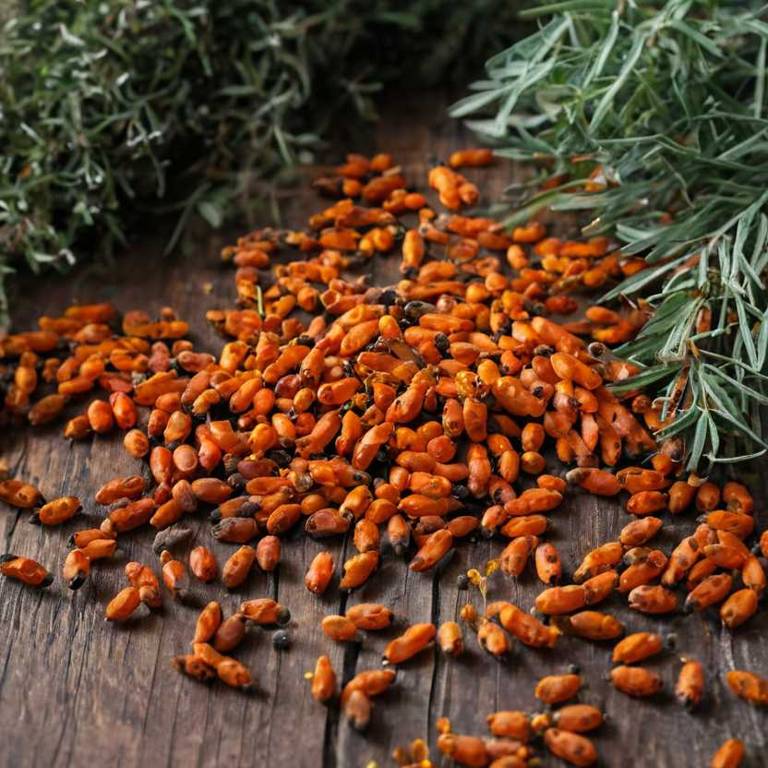10 Best Hippophae Rhamnoides Preparations

The best medicinal preparations of Hippophae rhamnoides are teas, decoctions, tinctures, oils, and creams, each offering unique benefits for health and wellness.
Teas made from the dried berries are commonly used to support digestion and boost immunity.
Decoctions involve simmering the plant material to extract its nutrients, often used for skin conditions and respiratory health.
Tinctures provide a concentrated form of the herb, ideal for internal use and quick absorption.
Oils and creams made from the berries are popular for their moisturizing and anti-inflammatory properties, making them valuable in skincare and topical treatments.
Below there's a list of the 10 best herbal preparations of hippophae rhamnoides for medicinal purposes.
- 1. Teas
- 2. Decoctions
- 3. Tinctures
- 4. Oils
- 5. Creams
- 6. Syrups
- 7. Mucillages
- 8. Capsules
- 9. Lozenges
- 10. Oinments
1. Teas
Hippophae rhamnoides teas is commonly used to support digestive health, reduce inflammation, and boost the immune system.
This herbal preparation is widely utilized for treating ailments such as gastrointestinal disorders, skin conditions, and respiratory infections. The most common medicinal uses include alleviating symptoms of indigestion, soothing skin irritations, and enhancing overall vitality. The bioactive constituents responsible for its medicinal properties include vitamins C and E, carotenoids, flavonoids, and essential fatty acids.
These compounds contribute to its antioxidant, anti-inflammatory, and immunomodulatory effects.

2. Decoctions
Hippophae rhamnoides decoctions is commonly used to treat digestive issues, skin conditions, and respiratory ailments.
This herbal preparation is often employed for its anti-inflammatory, antioxidant, and immunostimulant properties. It is frequently used to alleviate symptoms of gastritis, ulcers, and inflammatory bowel diseases. The decoctions are also applied topically to heal wounds and reduce skin inflammation.
Common bioactive constituents include vitamins C and E, carotenoids, flavonoids, and essential fatty acids, which contribute to its therapeutic effects.

3. Tinctures
Hippophae rhamnoides tinctures is commonly used to support immune function, reduce inflammation, and promote skin health.
These preparations are often employed to treat ailments such as respiratory infections, digestive disorders, and skin conditions like eczema and psoriasis. The most common medicinal uses include alleviating symptoms of colds, flu, and bronchitis, as well as supporting liver function and reducing oxidative stress. The bioactive constituents responsible for these effects include vitamins C and E, carotenoids, flavonoids, and essential fatty acids.
These compounds work synergistically to provide antioxidant, anti-inflammatory, and immunomodulatory benefits.

4. Oils
Hippophae rhamnoides oils is commonly used to treat skin conditions, digestive issues, and respiratory ailments due to its rich nutrient profile.
The most common medicinal uses include soothing eczema, psoriasis, and other inflammatory skin disorders, as well as aiding digestion and alleviating symptoms of the common cold and bronchitis. This oil is also valued for its antioxidant and anti-inflammatory properties, which support immune function and reduce oxidative stress in the body. The bioactive constituents responsible for these effects include vitamins A and E, carotenoids, flavonoids, and essential fatty acids.
These compounds work synergistically to provide the oil's therapeutic benefits for a variety of health conditions.

5. Creams
Hippophae rhamnoides creams is commonly used to treat skin conditions, inflammatory disorders, and to promote wound healing.
These creams are widely applied for their anti-inflammatory, antioxidant, and moisturizing properties. They are often used to alleviate symptoms of eczema, psoriasis, and dermatitis. The bioactive constituents include vitamins A and C, flavonoids, carotenoids, and essential fatty acids, which contribute to their therapeutic effects.
These compounds help reduce oxidative stress, enhance skin barrier function, and support overall skin health.

6. Syrups
Hippophae rhamnoides syrups is commonly used to support respiratory health, digestive function, and skin conditions.
These syrups are often employed to treat ailments such as coughs, bronchitis, gastrointestinal disorders, and inflammatory skin conditions. The medicinal properties of this preparation are attributed to its bioactive constituents, including vitamins C and E, carotenoids, flavonoids, and essential fatty acids. These compounds exhibit antioxidant, anti-inflammatory, and immune-boosting effects.
Additionally, the syrup may aid in reducing oxidative stress and promoting overall wellness.

7. Mucillages
Hippophae rhamnoides mucillages is commonly used to treat digestive disorders, skin conditions, and inflammatory diseases due to its soothing and healing properties.
The most common medicinal uses include alleviating symptoms of gastritis, ulcers, eczema, and respiratory tract infections. It is also used in skincare products for its moisturizing and anti-inflammatory effects. The bioactive constituents responsible for these properties include polysaccharides, flavonoids, tocopherols, and phenolic compounds.
These components contribute to its antioxidant, anti-inflammatory, and wound-healing abilities.

8. Capsules
Hippophae rhamnoides capsules is commonly used to support immune function, improve skin health, and aid in the treatment of digestive issues.
These capsules are often used to address ailments such as colds, flu, oxidative stress, and inflammatory conditions. The most common medicinal uses include boosting the immune system, promoting skin rejuvenation, and supporting cardiovascular health. The bioactive constituents responsible for these effects include vitamins C and E, carotenoids, flavonoids, and essential fatty acids.
These compounds work synergistically to provide antioxidant, anti-inflammatory, and immune-modulating benefits.

9. Lozenges
Hippophae rhamnoides lozenges is commonly used to treat respiratory and throat conditions such as sore throat, cough, and inflammation.
These lozenges are also used to support immune function and alleviate symptoms of colds and flu. The most common medicinal uses include relief from throat irritation, reduction of inflammation, and boosting the body's defenses against infections. The bioactive constituents responsible for these effects include vitamins C and E, flavonoids, carotenoids, and unsaturated fatty acids.
These compounds contribute to antioxidant, anti-inflammatory, and immunomodulatory properties.

10. Oinments
Hippophae rhamnoides oinments is commonly used to treat skin conditions, inflammatory disorders, and wound healing.
These preparations are widely applied for their anti-inflammatory, antioxidant, and antimicrobial properties. The most common medicinal uses include treating eczema, psoriasis, burns, and other dermatological issues. They are also used to alleviate joint pain and inflammation associated with arthritis.
The bioactive constituents responsible for these effects include vitamins C and E, carotenoids, flavonoids, and essential fatty acids, which contribute to their therapeutic value.
